One of Chevrolet’s most successful engines ever, the small-block V8 is now an icon of the muscle car world.
The Chevrolet small-block V8 is without a doubt one of the most influential engines of the 20th century. With a vast number of iterations, and a production span of just under 50 years, the small-block has firmly shaped the way Chevy builds its engines even to this day.
Many of Chevrolet’s most iconic muscle cars feature a Chevy small-block, with the likes of the Corvette, the Z/28, and the Impala SS all using the smaller yet mighty beating heart at the core of their configuration. Yet, the engine wasn’t limited to smaller vehicles either, with even some SUVs and trucks being powered by different iterations of the design. All in all, the small-block was an incredibly successful and dynamic engine, that was modified and thrown into a variety of cars in its long reign.
In this article, we’ll take a deep dive into the history of Chevy’s small-block V8, looking at everything from its early days to the legacy it left behind; the legendary machines it powered; and the impact it made on American car culture for muscle cars and the wider community.
The Genesis Of The Chevrolet Small-Block V8

265 Engine Specs
Manufacturer
Chevrolet
Production Years
1955-1957
Configuration
90° V8
Displacement
4.3 liters (265 cu in)
Power
162-240 hp
Torque
260-270 lb-ft
Fuel
Gasoline
Noteworthy Applications
Corvette C1, Bel Air
In the early 1950s, Chevrolet recognized the need for a powerful and compact engine that could deliver impressive performance while fitting into a wide range of vehicles. Thus, the Chevrolet small-block V8 was born. Introduced in 1955, it set the stage for an era of extraordinary performance that would forever shape the landscape of American muscle cars.
The small-block V8 was a marvel of engineering, boasting a compact design and lightweight construction that defied conventional norms. Its innovative architecture incorporated features such as overhead valves, a deep-skirted block, and a detachable intake manifold. These advancements not only optimized performance but also simplified maintenance and even allowed for easier customization.
The first iteration of the small-block V8, often referred to as the “Gen 1” or the “mouse motor,” quickly gained popularity among the car community. It offered a range of displacements, from the initial 265 cubic inch to the later 283 and 327 variants. With its impressive power output, the original small-block V8 became the heart and soul of numerous classic American muscle cars, including the iconic C1 Corvette and the equally brilliant Bel Air. That’s not to say it was always a smooth ride for the small-block, with the 267 version often being regarded as one of the worst engines ever built. The engine would bounce back though, and go on to have one of the greatest engine reigns in American automotive history.
Performance And Engineering Breakthroughs

400 Engine Specs
The Chevrolet small-block V8 has long been celebrated for its exceptional performance and engineering breakthroughs. Over the years, Chevrolet introduced several notable advancements and performance variants that cemented the small-block V8’s status as not just an icon of American muscle car culture, but a game-changer in the automotive world.
One of the most notable changes to the small-block came in 1970, when it was used not to power a standard sedan or a high-performance muscle car, but a couple of SUVs. Produced from 1970 to 1980, the 400 offered a significant increase in displacement compared to previous iterations of the small-block V8. With its larger bore and stroke, the 400 V8 delivered impressive power and torque, making it a much more suited fit for SUVs. The engine’s larger size allowed for improved low-end torque, enhancing the vehicles’ towing and off-road capabilities, so whether traversing rugged terrains or hauling heavy loads, the 400 V8 provided the necessary power and reliability needed to get the job done. The 400 was one of the most radical redesigns of the small-block V8, and while it wasn’t fitted into any muscle car, the iteration still played an important role in the engine’s history, powering the likes of the iconic 70s K5 Blazer and the GMC Jimmy
The small-block V8’s engineering breakthroughs extended beyond raw power however, as Chevrolet implemented advancements in materials and manufacturing techniques to improve both durability and performance: with lightweight components, advanced cooling systems, and refined combustion processes all added throughout the years. These engineering innovations not only elevated the performance of the engines but also set new standards for the industry as a whole.
The Best Muscle Cars Powered By The Small-Block V8

While a lot of the time Chevy’s biggest engines take the praise of muscle car enthusiasts, it was the small-block that helped power many racing homologation specials and other great muscle cars. The Chevrolet small-block V8 has left a legendary mark on the world of muscle cars, and many of the brilliant machines that housed the engine are considered to be some of the best Chevrolet have produced. It would take a much longer article than this one to go into depth about every single great small-block V8 muscle car, but there are a few that are worth a very special mention.
One standout example is the 1969 Chevrolet Camaro Z/28, a very special American muscle car. With the new for 1967 302 Small-Block V8 under its hood specifically designed for the Z/28 and purpose-built for Trans-Am racing, the Camaro Z/28 became a symbol of Chevrolet’s performance. This engine was a technological marvel for the time, combining a forged steel crankshaft, high-performance solid lifters, and a high-flow aluminum intake manifold. With a factory-rated output of 290 hp, the Camaro Z/28 delivered outstanding performance despite its modest displacement.
Another muscle car that owes much of its greatness to the Small-Block V8 is the legendary Corvette. Throughout its storied history, this iconic engine has consistently powered the Corvette. The small-block V8’s incredible torque and horsepower output became the heartbeat of many Corvettes, combining with the car’s exceptional handling to create an almost unbeatable driving experience. And yes, there is a lot of debate as to exactly which Corvettes count as being muscle cars, but pretty much everybody agrees that the C3 model is the most muscular of the lot. With the 1970 model putting a huge 370hp despite only using the 5.7-liter small-block, the engine helped keep the Corvette name alive. Then, when the mid-’70s oil crisis rolled around, the small-block became an even more pivotal part of the Corvette’s survival, with many other sports cars and muscle cars meeting their demise, due to restrictions and pushes for more economical machines.
The Corvette and Camaro have gained a lot of success in sales and on the racetrack thanks to Chevy’s small-block V8, and without the mighty engine, these legendary muscle cars may never have seen the light of day.
The Chevrolet Small-Block V8’s Impact On American Culture

The influence of the Chevrolet Small-Block V8 extends far beyond its performance capabilities and contribution to muscle cars. This remarkable engine has left a permanent mark on American muscle car culture, becoming a symbol of power, innovation, and timeless performance.
One of the remarkable aspects of the small-block V8 is its enduring popularity among racing and hot rod enthusiasts. Many of the original small-block engines are still produced in crate format, allowing builders and enthusiasts to harness the power and reliability of these iconic engines in their custom projects. Whether it’s a classic hot rod, a drag racing machine, or a high-performance street car, the small-block V8 continues to be a sought-after engine, providing a foundation for limitless automotive creativity and inspiring some of the coolest custom-builds you’re ever likely to see.
Moreover, the sheer production numbers of the small-block V8 are a testament to its widespread popularity and impact. By late 2011, over 100,000,000 small-blocks had been built in carburetted and fuel-injected forms since its introduction in 1955. This astonishing figure solidifies the small-block V8’s status as one of the most prolific and beloved engines of the 20th century. It has not only powered countless vehicles but has also become an integral part of American automotive history.